Physical Address
304 North Cardinal St.
Dorchester Center, MA 02124
(see Fig. 18.1A,B )
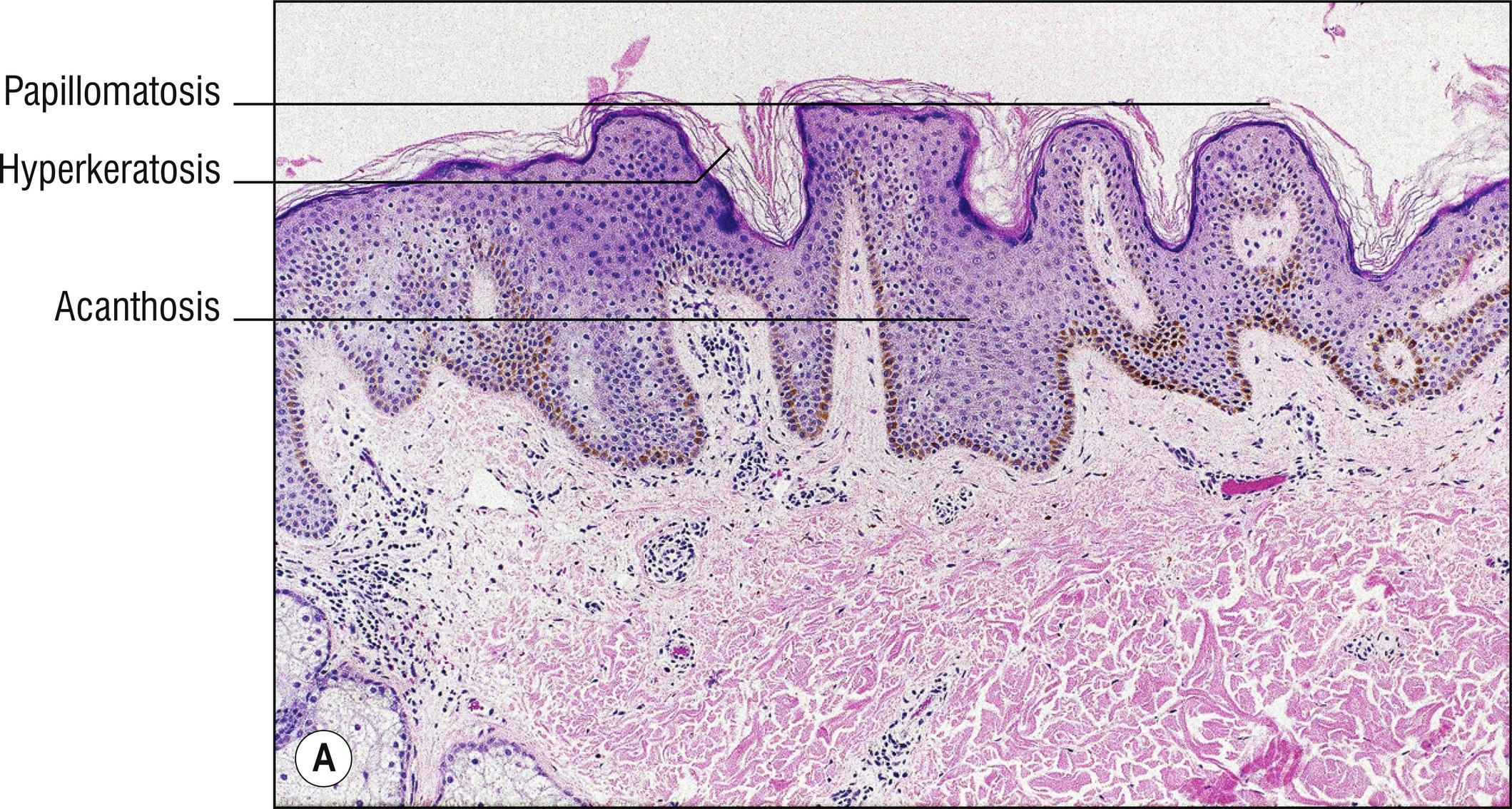
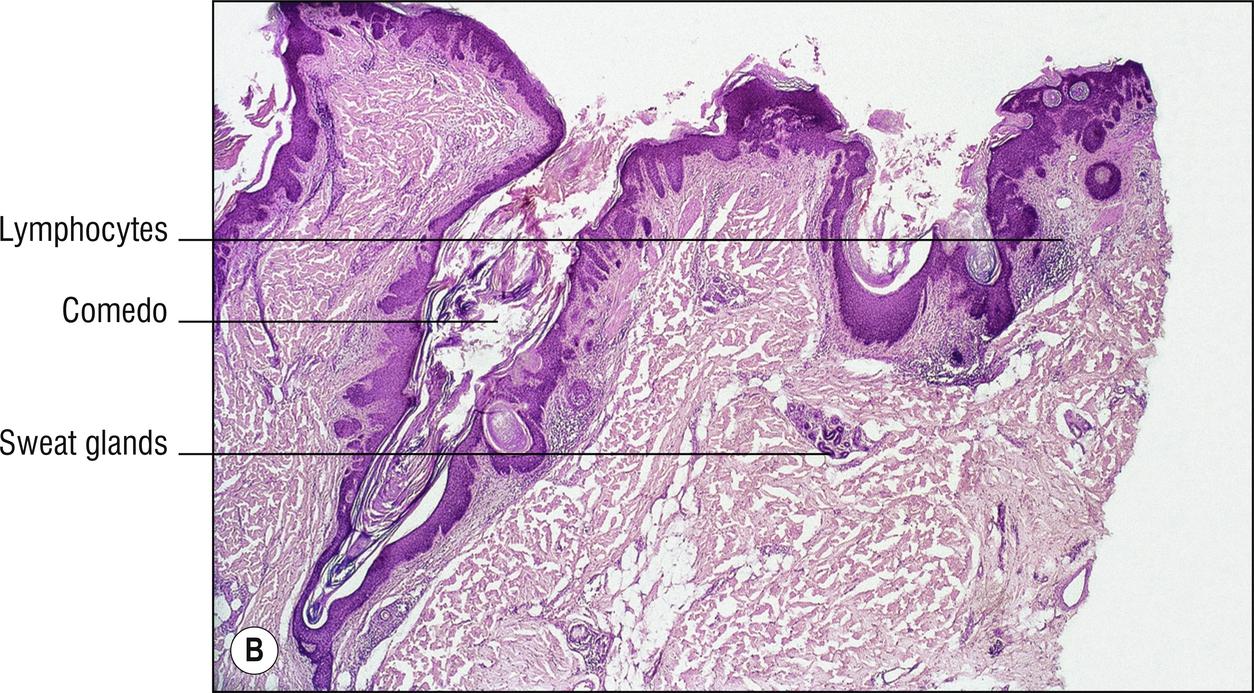
Somewhat common, linear , warty plaque , usually on the extremities, sometimes on trunk, since birth or early childhood, persists indefinitely. Sometimes lesions are more subtle, more macular, or they may have a grouping of papules, or may have pigmentary alterations. They may follow Blashko’s lines, sometimes related to a post-zygotic somatic mosaicism for mutations in the FGFR3 gene or PIK3CA gene, which also has been found in families with seborrheic keratoses. It is a congenital hamartoma (nevus) of proliferating epidermis, while most other nevi are melanocytic (20.5).
Hyperkeratosis, papillomatosis, acanthosis, sometimes hypergranulosis
Epidermolytic hyperkeratosis rarely (11.1)
Acantholytic dyskeratosis rarely (11.3)
Perivascular lymphocytes often
Nevus comedonicus (acne nevus): numerous open comedones in the linear plaque, may resemble acne. Sometimes associated with craniosynostosis, syndactyly, and FGFR2 mutation. May be a mosaic Apert syndrome.
Epidermal nevus syndrome: associated with ocular, skeletal, or neurological disease. Usually these are larger epidermal nevi. Similar to nevus sebaceus syndrome (21.2).
Linear porokeratosis: cornoid lamellae (18.4).
Linear basal cell nevus: identical to basal cell carcinoma (BCC), but starts in childhood and is linear.
Nevus unius lateris: extensive unilateral plaque with abrupt midline demarcation, usually on the trunk.
Systematized epidermal nevus (ichthyosis hystrix): literally “fish-porcupine,” term used when there is extensive involvement, usually on the trunk, often with a marble-cake whorled appearance. Whorling also occurs in incontinentia pigmenti (11.6), and hypomelanosis of Ito (11.7), but those conditions are more macular. May closely resemble some forms of ichthyosis (11.1).
Inflammatory linear verrucous epidermal nevus (ILVEN): more erythematous, more psoriasiform (1.119), and more lymphocytic inflammation. Parakeratosis with hypogranulosis often alternates with orthokeratosis and a prominent granular layer. Psoriasis is said to have more Ki-67 + nuclei, whereas ILVEN has more keratin-10 + cells.
Epidermolytic epidermal nevus: epidermolytic hyperkeratosis (11.1) occurs (keratin 1 and 10 defect).
Nevus sebaceus (21.2): the ultimate “lumper” considers nevus sebaceus to be a variant of epidermal nevus that occurs more on the head and neck, usually near the scalp, that has proliferating sebaceous and apocrine glands in addition to the papillomatous epidermis. With this concept, the other epidermal nevi without the sebaceous or apocrine gland components would be “keratinocytic epidermal nevi.”
Pigmented hairy epidermal nevus: see Becker’s nevus, 20.3.
Papular epidermal nevus with skyline basal layer (PENS): Rare variant with prominent basal layer resembling the eyeliner sign of Bowen’s disease (18.10).
Other papillomatous diseases (1.102) or linear diseases (1.73). Clinical information may be needed to make the distinction in some cases.
Seborrheic keratosis (18.2): may appear histologically identical, but usually is not linear and almost always starts after age 30 years old.
Lichen striatus (2.5): usually not present at birth, less hyperkeratosis and acanthosis, more spongiosis, more dyskeratosis, more lichenoid inflammation, resolves spontaneously.
(see Fig. 18.2A–H )
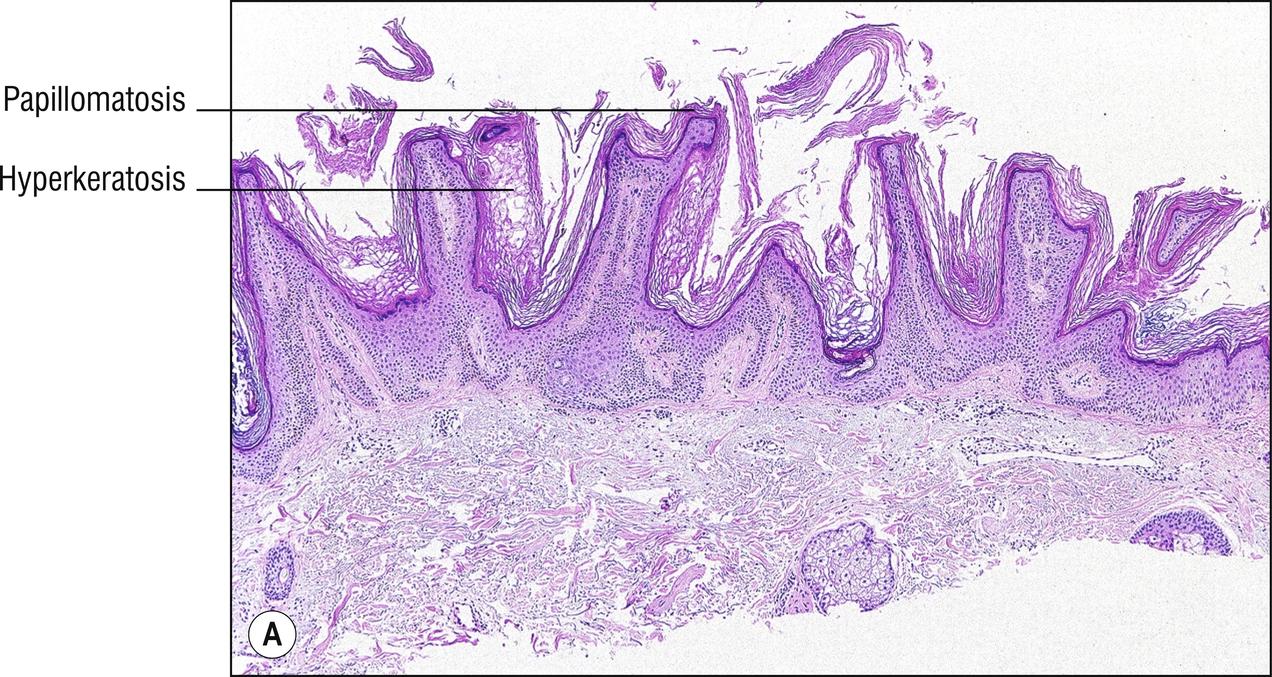
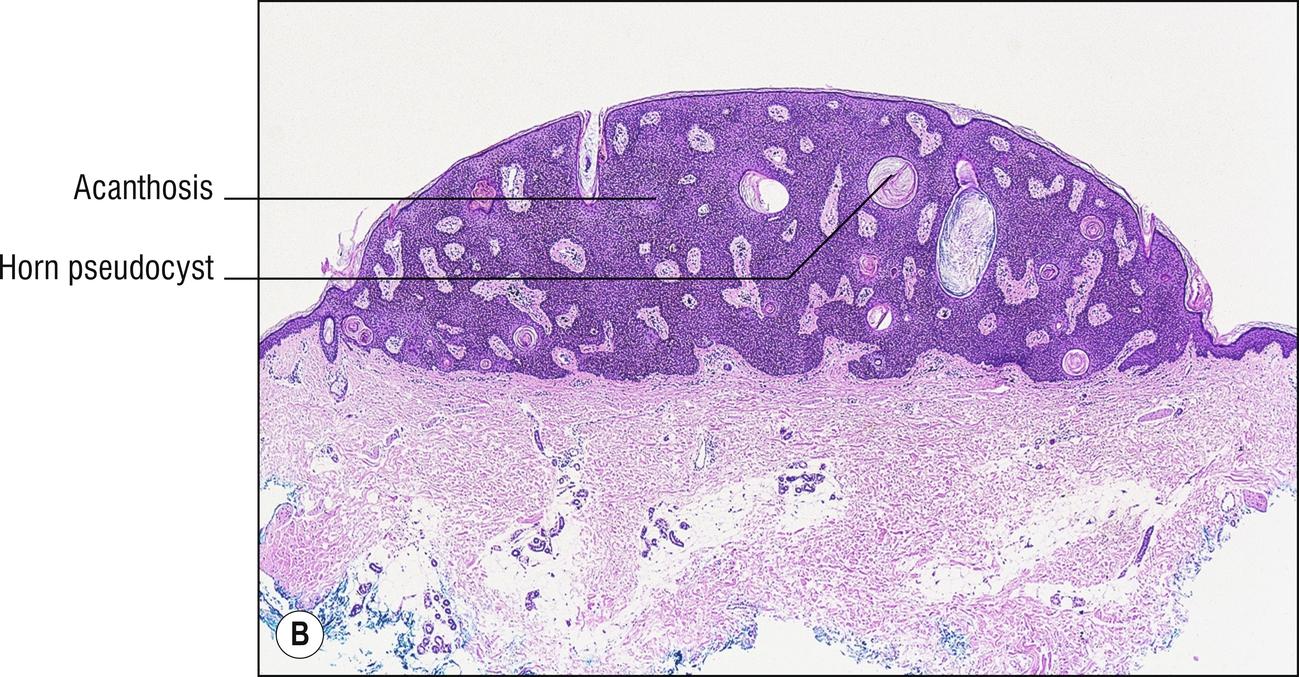
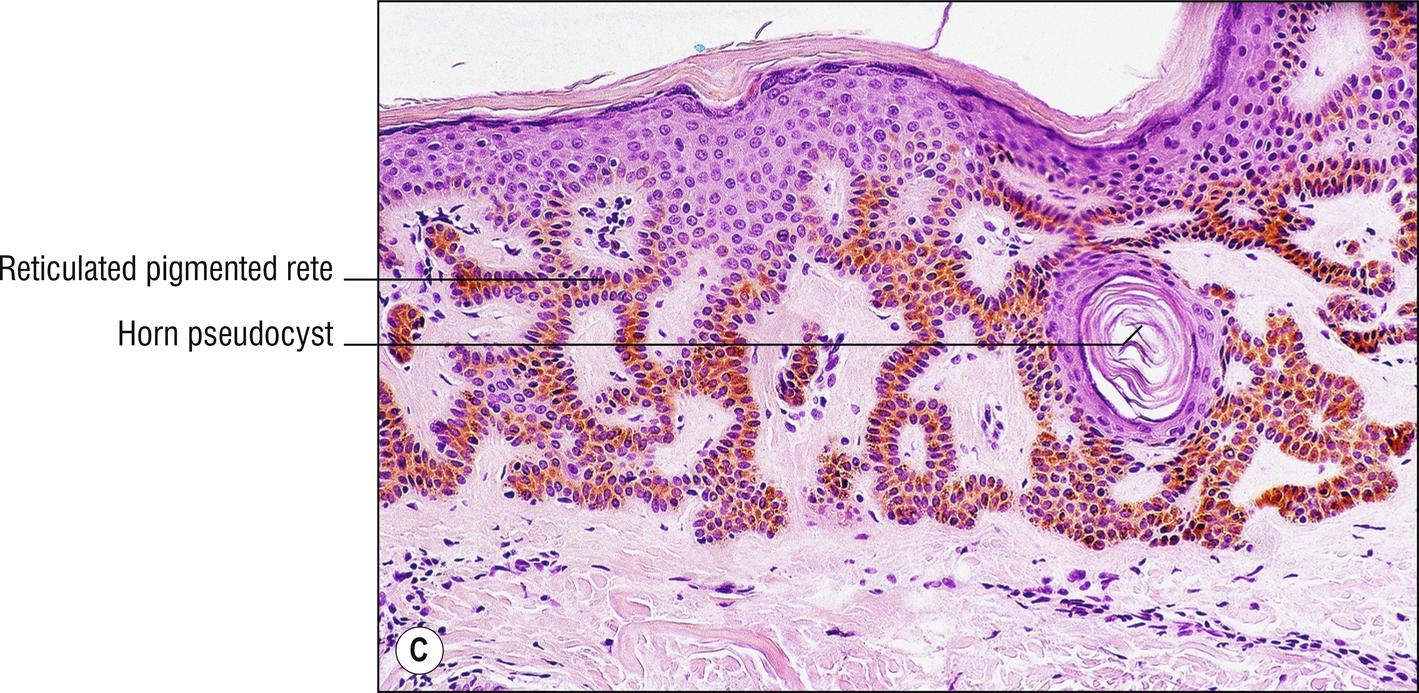
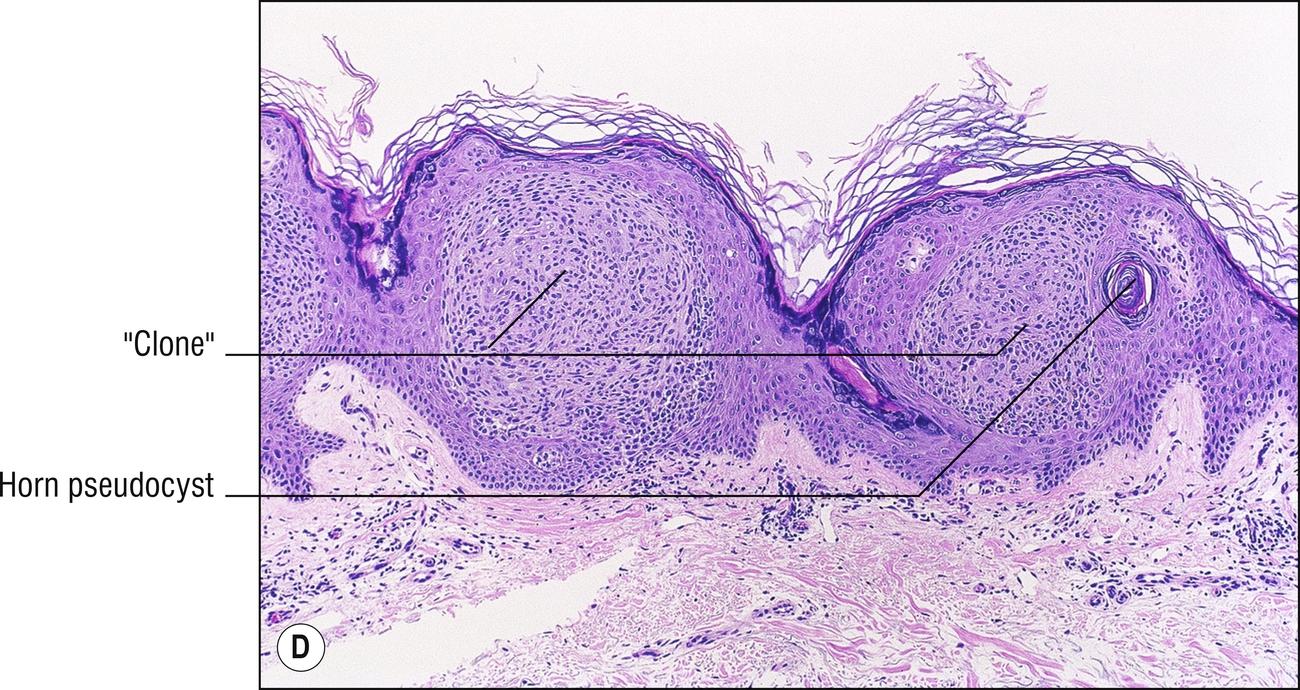
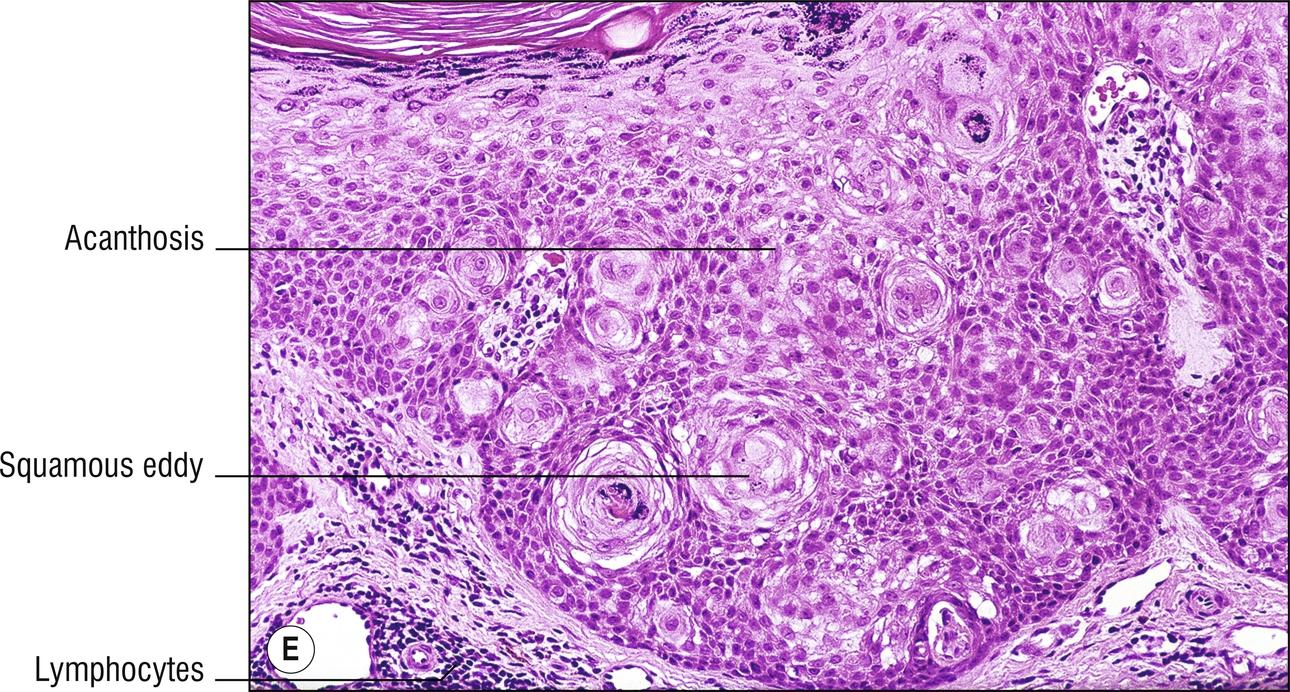
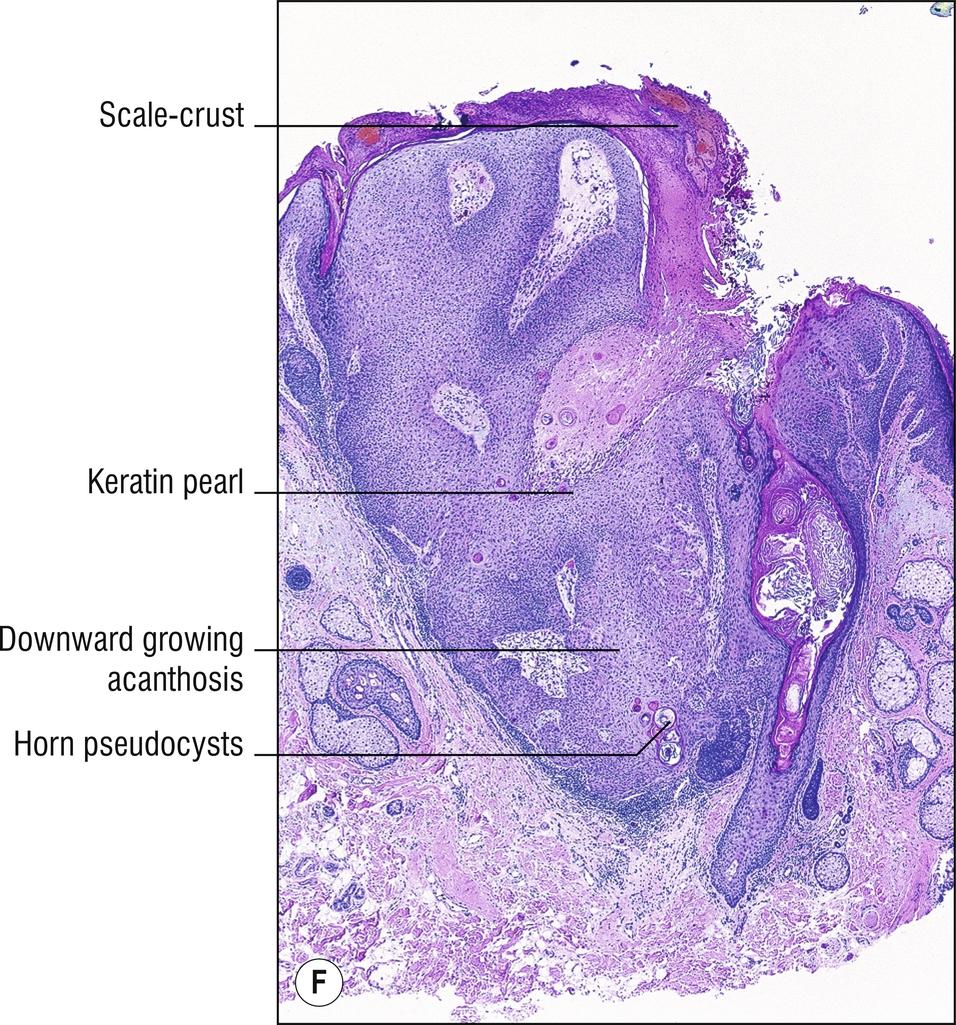
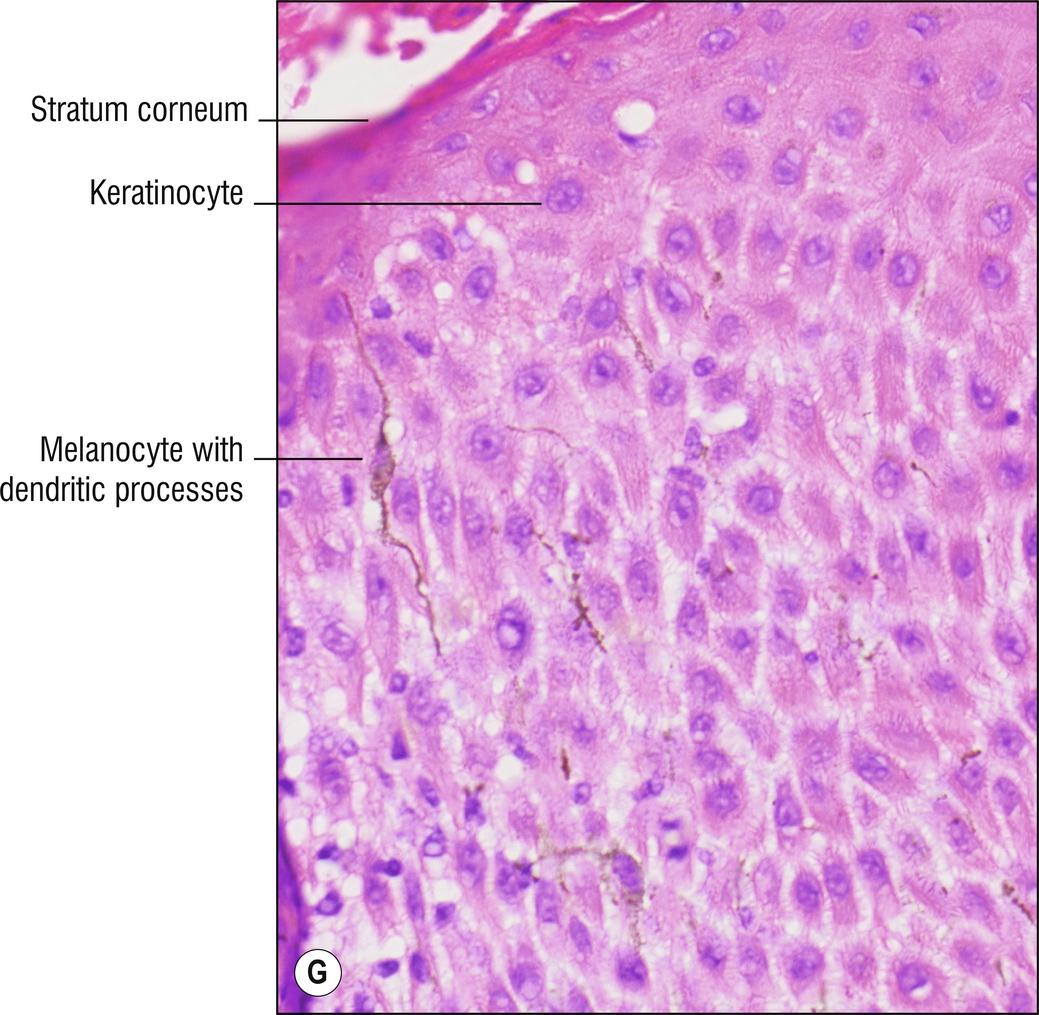
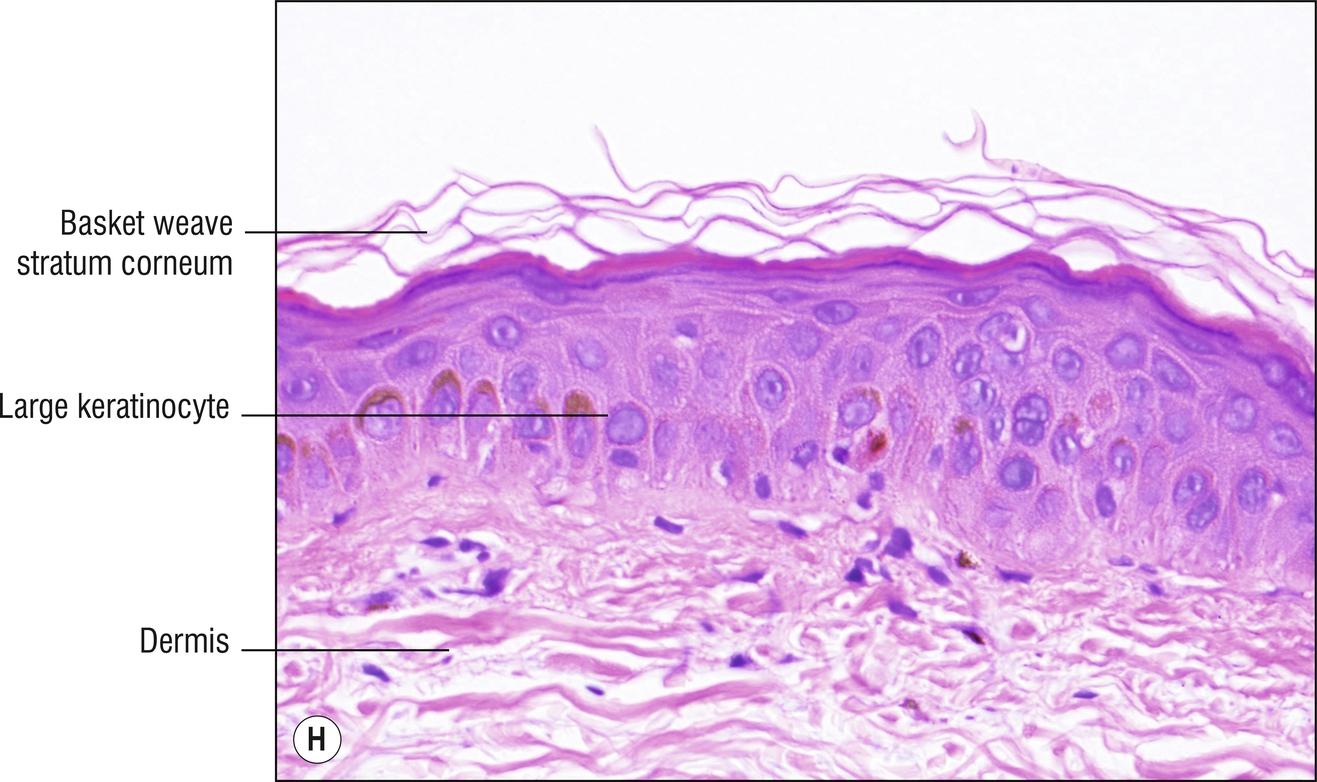
Very common stuck-on brown papules or plaques (aging barnacles) anywhere on the skin except palms and soles of patients over 30 years old. May look greasy, and common in areas with sebaceous glands (trunk and face), hence the name “seborrheic,” but they have nothing to do with sebaceous glands. Keratosis is a lesion with hyperkeratosis, since the suffix -osis means condition or disorder of. SKs have been found to have mutations in the RTK/PI3K/Akt signaling cascade.
Epidermal proliferation (variable combinations of hyperkeratosis, papillomatosis, acanthosis)
Keratinocytes often appear basaloid
Often horn pseudocysts (are called “pseudo” because they connect to surface, and represent papillomatosis)
Often abundant melanin in basal layer or throughout epidermis, derived from “passenger melanocytes,” which are not the main proliferating cells. Sometimes the term “pigmented seborrheic keratosis, PSK” is used, but the addition of “pigmented” is usually redundant since most SKs are pigmented
Sharp demarcation “ string sign ” of base of epidermal proliferation
Stucco keratosis (keratosis alba): white , more on lower legs of old patients, church-spire rete ridges, fewer horn cysts, and less melanin, similar to acrokeratosis verruciformis (18.3).
Hyperkeratotic SK: more hyperkeratosis , more papillomatosis , less melanin, fewer horn cysts.
Acanthotic SK: smooth , less warty surface , more likely to resemble a nevus clinically, more acanthosis, more melanin, less hyperkeratosis, less papillomatosis.
Reticulated (adenoid) SK: more on sun-exposed skin, thin, anastomosing net-like strands of epithelium (unfortunately called “adenoid” because dermal papillae as sectioned may vaguely resemble glands), may be related to, or arise from, a solar lentigo.
Macular SK (incipient SK): brown macule , more on sun-exposed skin, may arise in a solar lentigo, may eventually become a reticulated SK. Solar lentigo (20.4) has been considered to be associated with, or evolve into, macular SK, but macular SK has more compact stratum corneum, more acanthosis, and occasional early horn pseudocysts, compared with solar lentigo.
Large cell acanthoma: deemed by “splitters” to be a separate entity because of its large keratinocytes. Probably most cases are solar lentigo as it evolves into macular SK (see above). Some cases might be pigmented actinic keratosis or Bowen’s disease.
Dermatosis papulosa nigra: multiple tag-like black papules on face (1.44) of black patients , often numerous, smaller size, more melanin, less basaloid cells. The abbreviation DPN is commonly used, but unfortunately that also can stand for deep penetrating nevus (20.8).
Melanoacanthoma: extremely heavily pigmented acanthotic type of SK, may have increased dendritic melanocytes throughout epidermis.
Irritated or inflamed seborrheic keratosis (ISK): redness or crusting often present clinically. The “splitters” distinguish inflamed seborrheic keratosis (which just has inflammation , most commonly lymphocytes) from irritated seborrheic keratosis, which has crusting, squamous eddies or pearls (1.134), sometimes spongiosis (1.132), sometimes acantholysis (1.2), often mild or moderate atypia, may resemble squamous cell carcinoma (SCC, 18.11). Clinicians in the USA are pleased to have a report of inflamed or irritated SK because the insurance companies often do not pay for treatment of SKs that are not inflamed or irritated.
Borst–Jadassohn (clonal) SK: a variant of irritated SK (1.37) with discrete keratinocyte nests that appear different and demarcated from their neighbors, either because they are pale, dyskeratotic, or whorled.
Inverted follicular keratosis (IFK): irritated SK that grows downward along a follicle, with fewer clear cells than a trichilemmoma (22.5).
Tumor of the follicular infundibulum (22.5) might be considered a variant of SK by the “lumpers”.
Lichenoid keratosis (18.8).
Psoriasiform keratosis. This term has been used when an SK resembles other psoriasiform lesions (1.119).
Actinic keratosis (AK, 18.8): limited to sun-damaged areas, atypical keratinocytes and inflamed even when not “irritated”, usually no string sign, no horn pseudocysts, usually no pigment. When it is uncertain whether a lesion is verruca, SK, AK, or some other keratosis, the hedging terms BK (benign keratosis) or VK (verrucous keratosis) have been used.
Verruca vulgaris (14.1): mounds of parakeratosis, hypergranulosis, koilocytosis, and dilated vessels in papillae.
Other diseases with papillomatosis (1.102).
Other diseases with basaloid cells (1.11).
Other diseases with horn cysts (1.59).
Melanocytic neoplasms rarely can be difficult to distinguish when SKs have increased melanocytes, or when the melanocytic neoplasms have epidermal changes resembling SK. Examples include subtle examples of lentigo maligna (20.11, may be difficult to distinguish pigmented AK or macular SK), dysplastic nevus (20.7, some have SK silhouette with horn pseudocysts), or verrucous melanoma (20.11).
(see Fig. 18.3 )
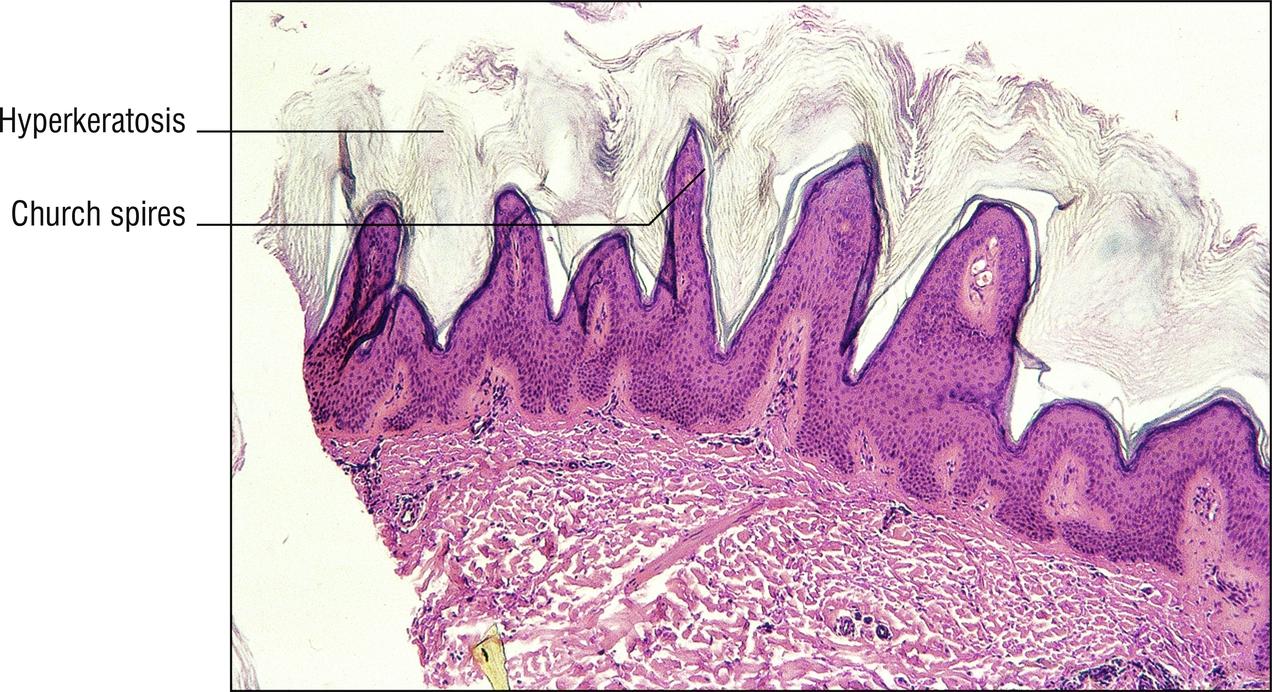
Rare, small warty papules on the dorsum of acral forearms, hands, and feet (1.56), genetically inherited, often associated with Darier’s disease (11.3), and related to the same ATP2A2 gene mutation.
Orthokeratosis, hypergranulosis (1.60), acanthosis (1.61)
Papillomatosis, often resembling church spires
Viral warts (14.1): koilocytosis, mounds of parakeratosis, dilated blood vessels in the dermal papillae.
Other diseases with papillomatosis (1.102): differentiation from hyperkeratotic seborrheic keratosis or stucco keratosis (18.2) is impossible without clinical information.
(see Fig. 18.4A–C )



Uncommon annular (1.5) hyperkeratotic papule or plaque with a thread-like elevated border . It is a misnomer, as porokeratosis has nothing to do with pores of sweat glands. Some forms of porokeratosis can develop SCC.
Cornoid lamella (a column of parakeratosis under which there is hypogranulosis and keratinocytes with dyskeratosis or pale staining) corresponding to the annular ridge seen clinically. Usually on a transverse section there is a cornoid lamella at both two-dimensional edges of the specimen, with the superficial surface of column slanting toward the inside of the lesion, like smoke trailing behind a train, but multiple haphazard cornoid lamellae may be present in the same biopsy
Epidermis in central part of lesion may be normal, hyperplastic, or atrophic (1.9)
Perivascular (1.109) or lichenoid (1.72) lymphocytes, sometimes localized beneath cornoid lamella
Superficial disseminated porokeratosis: numerous lesions, not apparently related to the sun.
Disseminated superficial actinic porokeratosis (DSAP): associated with SART3 gene mutations, numerous lesions, questionable relationship to the sun, most common on the legs (1.67), cornoid lamella may be subtle and easily missed.
Porokeratosis of Mibelli: solitary, larger variant, more hyperkeratotic, prominent cornoid lamella.
Porokeratosis punctata palmaris et plantaris: discrete small foci of hyperkeratosis of palms and soles, resembling punctate keratoderma (2.15), except that cornoid lamellae are present.
Linear porokeratosis: an epidermal nevus variant (18.1) with cornoid lamellae.
Other diseases with parakeratosis (1.104) or hyperplasia of epidermis (1.61). It is easy to miss this diagnosis if the cornoid lamella is not recognized.
(see Fig. 18.5 )

Somewhat common, velvety papillomatous hyperpigmented plaques , most common on the axilla (1.10) and neck (1.86), associated with diabetes mellitus (1.26), endocrinopathies, obesity, or internal malignancy (1.105). It is not a neoplasm, but is included in this chapter because of its resemblance to seborrheic keratosis histologically.
Hyperkeratosis, papillomatosis
Acanthosis minimal or absent (a misnomer)
Basal layer hyperpigmentation often
Confluent and reticulated papillomatosis of Gougerot and Carteaud: more generalized on the trunk, more reticulated (1.123), more stuck-on scale and less velvety, Pityrosporum often present, may respond to minocycline.
Pseudoacanthosis nigricans: only “splitters” make the distinction, associated with obesity, resolves with weight loss.
Malignant acanthosis nigricans: associated with internal malignancy.
Tripe palm (acanthosis palmaris): velvety changes of the palms associated with internal malignancy (1.105).
Become a Clinical Tree membership for Full access and enjoy Unlimited articles
If you are a member. Log in here